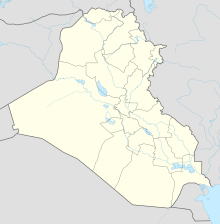Zabalam
Coordinates: 31 ° 45 ' N , 45 ° 53' E
Zabalam was a Sumerian city in southern Mesopotamia . The place was inhabited from the Uruk III period to the Old Babylonian period . The city was an important place of worship for the goddess Inana / Ištar .
Surname
The name of the city is documented from Uruk III (3100–2900 BC). It was written with the characters AB / UNUG.MÙŠ, where MÙŠ is a logogram for Inana and AB / UNUG means "place" or a specific building. In the ancient Babylonian period, the logogram for the city was either read “Zabala” or “Sugal”. The latter reading was the Akkadian name of the city at the time, and S / Šugallītu was the Akkadian name for Ištar of Zabalam.
excavation
The city was located in modern Ibzēḫ / Buzaiḫ. The place is located 8 km north of Tall Ğūḫa ( Umma ) and 14 km north-north-west of Umm al-ʿAqārib. Robbery excavations began in the 1920s at the latest and intensified after the Second Gulf War . The State Board of Antiquities and Heritage in Iraq undertook official excavations in 2001–2002 to protect the site from looting. Due to the permanent and intensive robbery excavations, the place is almost completely destroyed today and irretrievably lost to archeology. During the surveys by Robert McCormick Adams and Hans J. Nissen , objects from the middle Uruk period to the ancient Babylonian period were found.
In the old Babylonian period there was another city, also called Zabalam, in the area of Terqa .
swell
Because of robbery excavations, the text corpus of Zabalam is almost indeterminate. A group of texts receives indications that the texts come from Zabalam. Most of these texts belong to the temple archives or to archives from other large households, which can be called "palaces".
history
Uruk III
In the time of Uruk III, Zabalam was a member of the city association under the leadership of Uruk . Zabalam obviously played a major role, since it is already part of a group of cities in the “Archaic List of Cities”, together with Ur , Nippur , Uruk and Larsa . The city was already known as an important center of the Inana cult at this time.
Early Dynastic Period
From the early dynastic IIIb period, texts from a period of around 100 years have been documented. The city was dependent on Umma . The economy was concentrated around the temple of Inana. Economic activity was focused on the production and distribution of merchandise, agriculture, division of personnel and labor, and the purchase of land and houses. Two mathematical texts found indicate the existence of a writing school in the city.
Battery life
Zabalam was conquered by Sargon of Akkad , but remained under the influence of Umma. The city took part in the uprising against Rimuš and suffered a defeat. Lugalgalzu , the ruler of Zabalam, was captured. Later the city rebelled against Narām-Sîn together with other Sumerian cities ("Great Revolt"). Narām-Sîn and Šar-kali-šarri renovated various temples in Sumerian cities, including Inana's temple in Zabalam, as it was an important place of worship.
Ur-III period
Under the rule of the 3rd Dynasty of Ur, Zabalam still belonged to the province of the city of Umma. Because of the importance of the local cult of Inana, Zabalam was under the control of the royal family.
Old Babylonian time
Zabalam was a province of the empires of Isin , Larsa and Babylon . The city had cultic significance until the ancient Babylonian period.
After this period, the city was likely to have been abandoned.
literature
Manuel Molina: Zabala / u (m). In: Michael P. Streck (et al.): Reallexikon der Assyriologie und Vorderasiatischen Aräologie. Volume 15, 2017, ISBN 978-3-11-046219-7 , pp. 170-174.
